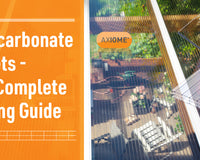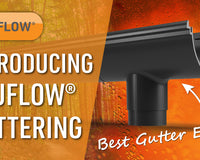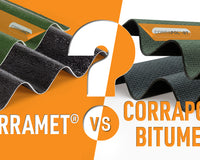The method of joining polycarbonate roofing sheets is often misunderstood by DIYers, when they want to cover a structure they have created, due to the number of factors involved. However, joining your polycarbonate sheet correctly is the most important point in ensuring a long-lasting installation as it is integral to the strength and durability of the roof.
There are many aspects to consider when deciding which polycarbonate joiners to use but here are the top 6 points you should consider before joining your roofing sheets. Click to jump a question to
- Which type of glazing bar to use?
- Which type of joiner is best - Plastic or Aluminium Glazing Bar?
- Are you joining Multiwall & Twinwall polycarbonate or Solid Polycarbonate?
- Can you screw Roofing Sheets down?
- Can you join polycarbonate sheets with glue?
- How to secure the edge or gable of a polycarbonate roof?
This article will help make each of these key points clearer and hopefully help you get the best out of your roof structure!
Before jumping into the main factors, it will be helpful to clarify as we often get asked; what is a glazing bar? A glazing bar is simply a strip designed to join polycarbonate sheets and secure them down to your roof rafters or self support the sheets over a span between two beams or structures. Glazing bars are most commonly manufactured from aluminium or PVC, with aluminium being the stronger option.
Other common names for glazing bars you may hear in the trade are polycarbonate sheet joining strips, h sections or h sections and roof sheet caps – which are all just other names for a glazing bar!
Which type of glazing bar to use?
There are two types of glazing bar systems available for joining polycarbonate sheets:
- Self Supported Glazing Bars
- Rafter Supported Glazing Bars
The most common application we find is that installers have already created a structure out of wood or similar material so there is a base that can be worked off. When there is a structure in place, you should use rafter supported glazing bars. Timber rafter glazing bars are available as Aluminium rafter Glazing Bars or PVC snap down glazing bars. Aluminium Glazing bars are stronger and high quality so often used for conservatory roofing whereas PVC glazing bars are budget and used for garden and DIY projects.
Where there is no structure in place, you will need to use a Self-Supporting glazing bar system which can span unsupported from two beams. A heavy duty self support glazing bar provides the structure for your polycarbonate roofing sheets to sit on, removing the need for supporting rafters.
As self supporting bars for polycarbonate, like 16mm Twinwall polycarbonate sheets, are manufactured from aluminium it can seem a more expensive option compared to a wooden structure but with the way the price of timber has increased over recent months it may actually prove as cost effective!
Whatever the type of structure you have in place, the joins need to support the full length of your roofing sheets.
Which type of joiner is best - Plastic or Aluminium Glazing Bar?
Aluminium Rafter Glazing Bars are typically most popular for medium to large projects at home and commercial projects where roof lifespan and quality are key factors. Popular applications for aluminium joiners include pergolas, gazebos and conservatories where their slim clean style stands out. More reasons to use aluminium bars are:
- Colour Options - The main benefit of aluminium sheet joiners versus PVC sheet joiners, beyond durability, is that aluminium glazing bars are available in white or brown and also can be coated in any colour!
- Long lifespan - The expected lifespan of the aluminium glazing bars is 20 years plus which means you have a durable, long-lasting option. No one wants to spend money on a project that is going to have to be re-done in just a few years.
- Ease of installation - Aluminium glazing are easy to install with any thickness of Solid or multiwall polycarbonate sheets
PVC Snap Down glazing bars are used where structures are maybe smaller and where budget is a key factor. Because plastic is a readily available material in today’s world and not as durable the cost of a PVC glazing bar is less than an aluminium glazing bar. One benefit of PVC sheet joiners is that they come in one colour – white – which makes for easy decision making!
As with the Aluminium bar systems, the PVC glazing bars are very easy to install and have an expected lifespan of 10 years which means it is a viable option to consider. PVC glazing bars will be more susceptible to weathering just because of the material they are manufactured from.
Are you joining Multiwall polycarbonate or Solid Polycarbonate?
There`s no huge difference in the method of joining solid polycarbonate sheets versus twinwall or multiwall polycarbonate sheet; both can be easily secured and installed. However, there are a couple of key points of difference that you need to think about:
Multiwall or Twinwall Polycarbonate Sheeting gives you more glazing bar options as you can use budget PVC Glazing bars which are snap fix so perfect for those with only a little DIY experience. The snap fix glazing bars are designed to snap to a certain thickness, for example 16mm or 25mm, so can be used exclusively with the multiwall polycarbonate sheeting.
This isn’t to say that the Aluminium Glazing Bar System can’t be used with your polycarbonate roofing sheets! In fact, aluminium glazing tends to be more popular in medium to large domestic projects and commercial projects due to its high quality and longer lifespan. With the aluminium glazing bars, you can get them in any RAL colour you like so where you have bronze or opal polycarbonate you can have matching aluminium rafter bars – or you can go to another colour completely!
Both glazing bar ranges have all the items you will need from Top wall Flashing, Wall Glazing Bars, to Joining/Glazing Bars and Drip trim.
Solid Polycarbonate Sheeting can only be installed with compatible aluminium glazing bars because this type of sheet, being a solid sheet, is heavier compared to multiwall polycarbonate therefore a heavier duty joining bar is required. As the weight is higher per square metre you will need a heavier-duty glazing bar and that is where popular ranges like the Alukap-XR and Alukap-SS step in. Unlike PVC Glazing bars these systems can work with any thickness of polycarbonate sheeting, including the most popular 6mm thickness.
If you are sheeting over a curved roof structure both types of polycarbonate sheets can be used, however, you will need to use a rafter support aluminium glazing bar system that is suitable to be curved to a radius. Alukap-XR Curved Glazing Bars are commonly used on roof lanterns, bike shelters, dug out shelters, curved roof lights and station canopies!

Alternative ways to join polycarbonate sheets
Can you screw Roofing Sheets down?
No, it is not recommended to screw polycarbonate sheets down to secure them. This is because the screws only secure that particular point of the sheet and not down the join the whole length of the plastic sheet, therefore, meaning your roof is less secure and can be damaged easily in storms.
Also, another risk when screwing roofing sheets down is if the roofing sheets aren’t fitted correctly with screws they can easily warp under expansion and contraction which can cause waterproofing problems further down the line!
In general, polycarbonate fixing buttons are used on cross purlins on wider sheets as a secondary fixing to reduce the risk of wind uplift. For every application it is always recommended to use a joining bar as the primary fixing method.
Can you join polycarbonate sheets with glue?
No, although gluing polycarbonate sheets may sound like a simple way to install it is not recommended as will have little strength against wind uplift or snow loading.
The best thing to create a long-lasting roof is to install the sheets using glazing bars. If you are using glue to seal around the side or ends of your polycarbonate roofing sheets then use a compatible LMN silicone sealant (Low Modulus Neutral Cure).
How to secure the edge or gable of a polycarbonate roof?
Generally, there are two ways a roof will finish on the side – either it’s up against another structure such as a wall or it will be open sided.
It’s important to finish this area correctly to protect against potential wind uplift, for waterproofing (if it’s against a wall) and also to help create a neat finish on the outside edge where it is visible. This is an area that has previously been hard to complete due to there either being only Lead Flashing, which works to a degree, or there were complicated, fiddly trims which were a nightmare to fit.
Thankfully, we have created innovative products to combat these and also ease installation!
For an open structure such as a Pergola, you would use a Gable bar for the sides of your roof. This easy to install innovation is manufactured in both PVC, Aluminium rafter supported and Aluminium self-supporting. What these Gable Bars achieve is an extremely simple way to finish the edge of the roof whilst securing the roofing sheet, keeping the waterproof properties, and keeping the style consistent across your roof.
Where the structure is up against the wall you should use a wall glazing bar to seal the side effectively and ensure the majority of water drains down off your roof rather than down the side of the wall. Traditionally this would have been a difficult, potentially ugly area to complete but now, with the Side Wall Bar, this is easy-to-finish with the same glazing bar style. Again the wall bar is available in PVC, Aluminium rafter supported and Aluminium self-supporting.
In conclusion – what is the best way to join the Polycarbonate Sheets?
The best way to join polycarbonate roofing sheets is with a glazing bar. Glazing bars primary come in PVC or aluminium options and are designed to make installation easy. Never think just using enough screws in the roof is a substitute as even with a large number of fixings a roof can easily uplift if not secured down with glazing bars as the primary fixing method.
In summary, joining your roofing sheets is one of the most important areas in creating a durable structure. They complete the roof, help create the look you want but most importantly are key to creating the durable structure you need. Available in either long-lasting Aluminium, or Plastic these glazing bars, or joining bars, are what you need to join your polycarbonate roofing sheets.
They are designed to be the main fixing point in the roof compared to screws which unfortunately don’t meet the requirement as they are a secondary fixing method.
Want to learn more about installing polycarbonate sheets?
To help make it easier for you, we have a range of How2 Install Videos available and on the Clear Amber YouTube Channel that are simple to follow and cover many essential installation stages. Also on the Product Pages, there are Technical Guides and Installation Guides with all the details if you prefer non-video style instructions!
Our Teams are also happy to assist on our Live Chat or you can email shop@clearamber.com where we will provide you with all the advice and support you require for your polycarbonate project.
















16 comments
Clear Amber Shop Team
Great question, James! Ideally you want to keep all sheets as single lengths, as a horizontal join (counter to the drainage direction of water) is always risky for leaks.
Good news is that we manufacture sheets longer than 3 meters, right up to 7 metres in fact! Check out our Axiome Clear 10mm Twinwall Polycarbonate Sheet page for more details.
James
Hello
Great article and really helpful. I want to put twin wall 10mm polycarbonate sheet on my pergola roof. The issue that i have is that my pergola is custom made and around 4m and 20cm long.
The sheets come in 3m length, how can I join two sheets together so they can reach the length of my pergola?
Thank you in advance.
Clear Amber Shop Team
It is important to know that joining polycarbonate sheets end-to-end is always challenging, especially getting a watertight seal, as any joints interrupt the drainage direction of rainwater off the roof.
To join Axiome polycarbonate sheets, you would use a Snapa Clear H section, which would need to be supported directly by a timber purlin and well sealed with a suitable sealant.
Nick John
We are replacing a flat roof which is between two buildings so it has to slope front to back not sideways. We need two sheets which will be laid end to end with then a join required in the middle where they meet. What is the best type of joiner? Look forward to hearing from you. Regards Nick
Clear Amber Shop
Thanks David, appreciate the comments and feedback. Always try our best to make life as easy as possible for the installer!
David S
Good quality products.
Excellent “How 2” videos. A company that supports the DIY’er to this level gets my vote. Well done!
Clear Amber Shop Team
Hello James, Thank you for your question online.
Although not a standard application, the Alukap-SS Slimline Glazing bars could definitely be used vertically. You would just need to ensure they were securely fixed back to a frame or similar structure.
You could then use our Axgard or Axiome polycarbonate sheets as the glazing – Axgard is stronger for vandal protection.
James Knott
Alukap-SS Slimline Glazing Bar – Is it possible to use this product to form a more robust frame for secondary glazing as vandal protection
Clear Amber Shop Team
Thanks Mick, yes the Top Wall Flashing will work for sealing against a rough cast wall on your polycarbonate sheet roof. Simply run a thick bead of Securbond along the back edge of the Top Wall Flashing to seal.
MickFlavin
Building a pergola wil the flashing work as in sealing against rough cast to make it water tight
Clear Amber Shop
Thanks Phil, the H sections can be more challenging to install which is one of the reasons why we always recommend use glazing bars, like our Snapa Snap fix bars for Polycarbonate sheets. Plus they give better waterproofing.
Anyhow, to install an H section it is best to line it up beside the edge of the first sheet and slot on to the polycarbonate sheet, starting one end and working your way down. Most installers find it best to use a flat tool like screwdriver to prise/hold the h section open to accept the sheets on the first part. And then slide the tool down as you go.
Phil
I have12 ft length twin wall, 8 mil.
Difficulty in sliding on the H- 8 mil 12 ft channel. It would appear that I need to hammer the end and use a liquid soap. Will that work or am I missing something?
Anonymous
Hello Barry, great question about using glazing bars to re-sheet a polytunnel. Yes, so if you wanted to split the polycarbonate sheet horizontally it would be best done at the ridge point. For this Aluminium glazing bars, like Alukap-XR, would be best, as plastic bars aren’t as strong to withstand the force of the curved sheeting.
BARRY DRENNAN
Can glazing-bars be used (vertically and horizontally) to connect polycarbonate sheets when exchanging the plastic-film covering on a arched (full-curve) greenhouse with polycarbonate sheeting? For this type of resurfacing which would be best; aluminum-glazing-bars or plastic-glazing-bars.
Anonymous
Thank you for the enquiry Jerry! Yes, it sounds like the Alukap-XR Aluminium Glazing Bars would be perfect for your pergola roof. One of the team will be in touch directly to help further.
Jerry lamb
I have built a 16’ by 14’ pergola. I have 4 by 8 polycarbonate sheets. I would like to see if you can help be figure out what I need. I would want the aluminum glazing bars in brown to join the pieces. And the aluminum brown gable bars for the edge trim. Any help you can give would be greatly appreciated. I also might need the the polycarbonate buttons to secure it as well. Please advise